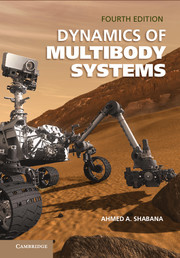Book contents
- Frontmatter
- Dedication
- Contents
- PREFACE
- 1 INTRODUCTION
- 2 REFERENCE KINEMATICS
- 3 ANALYTICAL TECHNIQUES
- 4 MECHANICS OF DEFORMABLE BODIES
- 5 FLOATING FRAME OF REFERENCE FORMULATION
- 6 FINITE-ELEMENT FORMULATION
- 7 THE LARGE DEFORMATION PROBLEM
- 8 CONCEPTS AND ESSENTIAL DETAILS
- APPENDIX: LINEAR ALGEBRA
- References
- Index
6 - FINITE-ELEMENT FORMULATION
Published online by Cambridge University Press: 05 June 2014
- Frontmatter
- Dedication
- Contents
- PREFACE
- 1 INTRODUCTION
- 2 REFERENCE KINEMATICS
- 3 ANALYTICAL TECHNIQUES
- 4 MECHANICS OF DEFORMABLE BODIES
- 5 FLOATING FRAME OF REFERENCE FORMULATION
- 6 FINITE-ELEMENT FORMULATION
- 7 THE LARGE DEFORMATION PROBLEM
- 8 CONCEPTS AND ESSENTIAL DETAILS
- APPENDIX: LINEAR ALGEBRA
- References
- Index
Summary
In the classical finite-element formulation for beams and plates, infinitesimal rotations are used as nodal coordinates. As a result, beams and plates are not considered as isoparametric elements. Rigid body motion of these non-isoparametric elements does not result in zero strains and exact modeling of the rigid body inertia using these elements cannot be obtained. In this chapter, a formulation for the large reference displacement and small deformation analysis of deformable bodies using nonisoparametric finite elements is presented. This formulation, in which infinitesimal rotations are used as nodal coordinates, leads to exact modeling of the rigid body dynamics and results in zero strains under an arbitrary rigid body motion. It is crucial in this formulation that the assumed displacement ield of the element can describe an arbitrary rigid body translation. Using this property and an intermediate element coordinate system, a concept similar to the parallel axis theorem used in rigid body dynamics can be applied to obtain an exact modeling of the rigid body inertia for deformable bodies that have complex geometrical shapes. More discussion on the use of the parallel axis theorem in modeling the inertia of rigid bodies with complex geometry is presented in Chapter 8 of this book.
- Type
- Chapter
- Information
- Dynamics of Multibody Systems , pp. 263 - 303Publisher: Cambridge University PressPrint publication year: 2013

